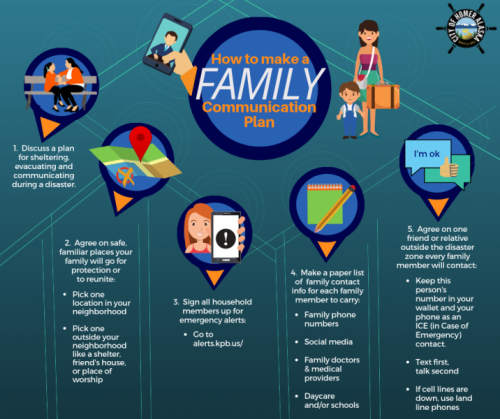-
About Homer
-
- Americans with Disabilities Act Compliance Program City Campgrounds Community Recreation Hickerson Memorial Cemetery
- Library Parks & Trails Public Safety Fire Police Emergency Information
- Events & Activities City Calendar Library Calendar Recreation Calendar Doing Business in Homer Sister City Program Coast Guard City
-
- Departments
- Government
- How Do I?
Communicating With Your Family & Friends During a Disaster
Don’t lose touch with your family during a disaster!
Emergencies can happen at any time. You will want to send and receive information from your family and friends.
“What if something happens and I’m not with my family?” “How will I know they are safe?” “How can I let them know I’m OK?”
A communication plan will help! Follow the steps in the diagram above to make a plan with your family so you don’t lose touch during a disaster.
Remember to Text First, Talk Second when communicating during an emergency event. While the desire to call and talk to your loved one during these incidents may be great, mobile phone calls can quickly overwhelm provider capacity. During an emergency and its immediate aftermath, communicating via SMS text messaging should be your first choice.
Text messages get through even when voice networks are congested. So in an emergency:
- Let your friends and loved ones know you are okay with a text message, not a call
- Keep your text message short: R U OK? and I M OK.
- Do not use your phone unless you absolutely need to.
Image Description: The Photo is titled Communicating with your Family During an Emergency.
Step One: discuss a plan for sheltering, evacuating and communicating during a disaster.
Step 2: Agree on safe familiar places your family will go for protection or to reunite. Pick one location in your neighborhood. Pick one outside your neighborhood like a shelter, friend's house or place of worship.
Step Three: Sign all household members up for emergency alerts at alerts.kpb.us/
Step Four: Make a paper list of family contact info for each family member to carry. Include family phone numbers, social media, family doctors and medical providers, and daycare/school.
Step Five: Agree on one friend or relative outside the disaster zone every family member will contact. Keep this person's number in your wallet and list them on your phone as ICE (In Case of Emergency) contact. Don't forget to text first, talk second. If cell towers are down use land line phones.



